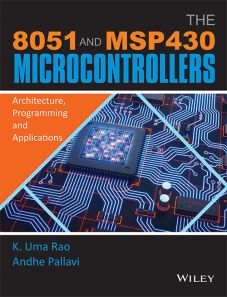The 8051 and MSP430 Microcontrollers: Architecture, Programming and Applications
ISBN: 9788126577545
504 pages
eBook also available for institutional users
For more information write to us at: acadmktg@wiley.com

Description
This book presents the key features, architecture and programming of 8051 and MSP430 in a simple lucid manner. The programming includes both Assembly Language and C programming. The book is written for a semester course and can be used by diploma and under graduate students.
Preface
Chapter 1 Computers, Microprocessors and Microcontrollers – An Introduction
1.1 Introduction
1.2 Common Terminologies Associated with Computing Systems
1.3 Microprocessors and Microcontrollers
1.4 CISC and RISC Systems
1.5 Computing Languages
1.6 Memory
1.7 Computer Architecture: Harvard and von Neumann
1.7.1 von Neumann Architecture: Princeton Architecture
1.7.2 Harvard Architecture
1.8 Evolution of Microcontrollers – 4 bit to 32 bit
Chapter 2 Data Representation
2.1 Introduction
2.2 Number System
2.3 Decimal Representation
2.4 Complements
2.5 Fixed-Point Representation
2.6 Floating-Point Representation
2.7 Other Binary Codes
Chapter 3 8051 Architecture
3.1 Introduction
3.2 Block Diagram of 8051
3.3 Pin Diagram of 8051
3.4 Clock and Machine Cycle for 8051
3.5 Registers of 8051
3.6 The 8051 Internal Memory
3.7 Stack and Stack Pointer
3.8 Timers and Counters
3.9 I/O Ports
3.10 Serial Input/Output
3.12 Supply Voltage
3.13 Status of SFR’s on Reset
3.14 Machine Cycles
3.15 Detailed Pin Description
Chapter 4 Assembly Language Programming I: Addressing Modes and Data Transfer
4.1 Introduction
4.2 Assembly Language
4.3 Flow Charts and Algorithm
4.4 8051 Data Types and Directives
4.5 Addressing Modes
4.6 Data Transfer with Stack
4.7 Data Exchange
4.8 Complete Set of Data Transfer Instructions
Chapter 5 Assembly Language Programming II: Arithmetic and Logic Operators
5.1 Introduction
5.2 Addition
5.3 Incrementing and Decrementing
5.4 Subtraction
5.5 Multiplication
5.6 Division
5.7 Decimal Addition
5.8 Summary of Arithmetic Operations of 8051
5.9 Logical Operations: Byte Level
5.10 CLEAR and COMPLEMENT Accumulator
5.11 Bit-Level Logical Operations
5.13 Swap Operation
5.14 Summary of Bit-Level Logical Operations
Chapter 6 Assembly Language III: Jump and Call Instructions
6.1 Introduction
6.2 Address Range of Jump and Call Instruction
6.4 CALL Instruction
Chapter 7 Programming 8051 with C
7.1 Introduction
7.2 Declaring Variables
7.3 Writing a Simple C Program
7.4 Delay Generation in C
7.5 Programming Ports of 8051 with C
7.6 Operators in 8051 C
7.7 Serial Port Programming using Shift Operators
7.8 Code Conversions in C & ALP
7.9 Code Space
Chapter 8 Timers / Counters and Serial Port in 8051
8.1 Introduction
8.2 Time Delay Generation Using Timers
8.3 Application of Timers in Mode 2
8.4 Counter Application
8.5 Serial Data Transfer
8.6 Second Serial Port in 8051
Chapter 9 Interrupts
9.1 Introduction
9.2 Review of Interrupts in 8051
9.3 External Interrupts
9.4 Serial Communication Interrupt
9.5 Priority Implementation for 8051 Interrupts
Chapter 10 Interfacing the 8051
10.1 Introduction
10.2 Interfacing a LED and a 7-Segment Display to an 8051
10.3 Interfacing a Single Key (Push Button) to the 8051
10.4 Matrix Keypad or Interfacing Keyboard to the 8051
10.5 Stepper Motor Interfacing to 8051
10.6 Interfacing a DAC to an 8051
10.7 DC Motor Interfacing to 8051
10.8 Analog-to-Digital Converters (ADC)
Chapter 11 Simulation of 8051 Using Keil Software (Lab Manual)
11.1 Introduction
11.2 Features of the 8051 Version Used
11.3 Creating and Compiling a μ Vision2 Project
11.4 Programming in ALP
11.5 Digital-to-Analog Converter (DAC) Interfacing to 8051
Chapter 12 MSP Microcontroller: Introduction and Key Features
12.1 Introduction
12.3 MSP430 RISC CPU Architecture
12.4 Details of 16-Bit RISC CPU
12.5 Clock System
12.6 Memory Subsystem
12.7 Key Differentiating Factors between Different Families
12.8 Digital I/O Ports
12.9 Muxing Scheme for MSP430 Pins
Chapter 13 On-Chip Peripherals, Interfacing and Applications of MSP430
13.1 Watchdog Timer
13.3 Comparator_A
13.4 ADC10 Successive-Approximation ADC
13.5 The SD16_A Sigma–Delta ADC
13.6 Operational Amplifiers
13.7 Timers
13.8 Real-Time Clock
13.9 DAC: Digital-to-Analog Conversion
13.10 Direct Memory Access (DMA)
13.11 LCD Controller
13.12 Case Studies of Applications of MSP430 – Data Acquisition System
13.13 Sensor Networks
Chapter 14 Programming the MSP430
14.1 Addressing Modes
14.2 Instruction Set of MSP430
14.3 Double Operand Core Instructions
14.4 Single Operand Core Instructions (Format II)
14.5 Program Flow Control – Jumps: Core Instructions (Format III)
14.6 Emulated Instructions
14.7 Movement Instructions
14.8 Implementation of Decimal Arithmetic
14.9 Shift and Rotate Instructions
14.10 Code Composer Essentials
14.11 Programming in ALP
14.12 C and Assembly C Projects for MSP430 Microcontrollers
14.13 Interrupts and Interrupt Programming
14.14 Low-Power Modes and Low-Power Programming
14.15 Interfacing LED/LCD/External Memory
Chapter 15 Application Development Using 8051
15.1 Support Structure for 8051-Based Product Development
15.2 Lab-Based Experiments: Design and Testing
15.3 Development of Mini Projects Based on 8051
15.4 Implementation of Real-World Projects Using Sensors and Actuators
15.4.1 Automatic Irrigation System
15.4.5 Wireless Home Security System Using PIR Sensor
15.5 Trends in Usage of 8051 in 32-bit Applications
Summary
Questions
Appendix
Index

